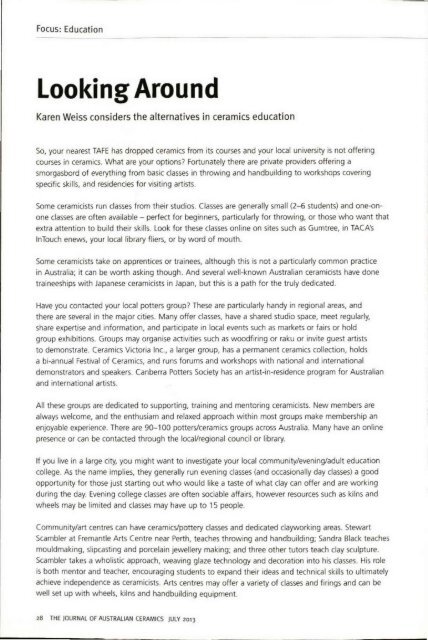The Journal of Australian Ceramics Vol 52 No 2 July 2013
Create successful ePaper yourself
Turn your PDF publications into a flip-book with our unique Google optimized e-Paper software.
Fo cus: Education<br />
looking Around<br />
Karen Weiss considers the alternatives in ceramics education<br />
So, your nearest TAFE has dropped ceramics from its cou rses and your local university is not <strong>of</strong>fering<br />
courses in ceramics. What are your options? Fortunately there are private providers <strong>of</strong>fering a<br />
smorgasbord <strong>of</strong> everything from basic classes in throwing and handbuilding to workshops covering<br />
specific skills, and residencies for visiting artists.<br />
Some ceramicists run classes from their studios. Classes are generally small (2-6 students) and one-onone<br />
classes are <strong>of</strong>ten available - perfect for beginners, particularly for throwing, or those who want that<br />
extra attention to build their skills. Look for these classes online on sites such as Gumtree, in TACA's<br />
InTouch enews, your local library fliers, or by word <strong>of</strong> mouth.<br />
Some ceramicists take on apprentices or trainees, although this is not a particularly common practice<br />
in Australia; it can be worth asking though. And several well-known <strong>Australian</strong> ceramicists have done<br />
traineeships with Japanese ceramicists in Japan, but this is a path for the truly dedicated.<br />
Have you contacted your local potters group? <strong>The</strong>se are particularly handy in regional areas, and<br />
there are several in the major cities. Many <strong>of</strong>fer classes, have a shared studio space, meet regularly,<br />
share expertise and information, and participate in local events such as markets or fairs or hold<br />
group exhibitions. Groups may organise activities such as woodfiring or raku or invite guest artists<br />
to demonstrate. <strong>Ceramics</strong> Victoria Inc., a larger group, has a permanent ceramics collection, holds<br />
a bi-annual Festival <strong>of</strong> <strong>Ceramics</strong>, and runs forums and workshops with national and international<br />
demonstrators and speakers. Canberra Potters Society has an artist-in-residence program for <strong>Australian</strong><br />
and international artists.<br />
All these groups are dedicated to supporting, training and mentoring ceramicists. New members are<br />
always welcome, and the enthusiam and relaxed approach within most groups make membership an<br />
enjoyable experience. <strong>The</strong>re are 90-100 potters/ceramics groups across Australia. Many have an online<br />
presence or can be contacted through the 10caVregionai councilor library.<br />
If you live in a large city, you might want to investigate your local community/evening/adult education<br />
college. As the name implies. they generally run even ing classes (and occasionally day classes) a good<br />
opportunity for those just starting out who would like a taste <strong>of</strong> what clay can <strong>of</strong>fer and are working<br />
during the day. Evening college classes are <strong>of</strong>ten sociable affairs, however resources such as kilns and<br />
wheels may be limited and classes may have up to 15 people.<br />
Community/art centres can have ceramics/pottery classes and dedicated clayworking areas. Stewart<br />
Scambler at Fremantle Arts Centre near Perth, teaches throwing and handbuilding; Sandra Black teaches<br />
mould making, slipcasting and porcelain jewellery making; and three other tutors teach clay sculpture.<br />
Scambler takes a wholistic approach, weaving glaze technology and decoration into his classes. His role<br />
is both mentor and teacher, encouraging students to expand their ideas and technical skills to ultimately<br />
achieve independence as ceram icists. Arts centres may <strong>of</strong>fer a variety <strong>of</strong> classes and firings and can be<br />
well set up with wheels, kilns and handbuilding equipment.<br />
28 THE IOURNAL OF AUSTRALIAN CERAMICS JULY <strong>2013</strong>

















